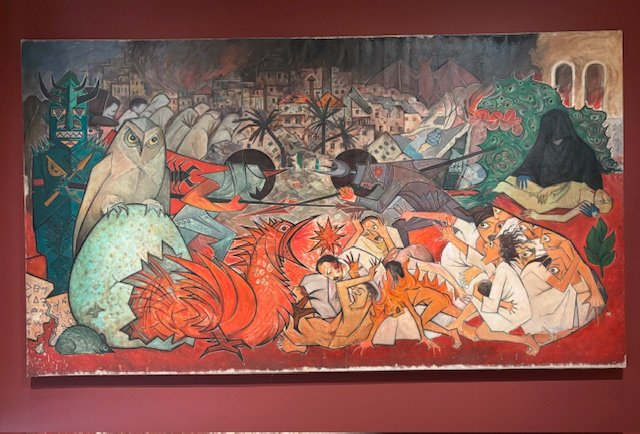An article by AV (898 Words, 5 Min. Read)
The Sursock Museum Opens Its Dors to a Stirring Tribute: Lebanon, The Heartbreak of War, and the Persistance of Memory. This Exh force
A Life Between Hamra and Odeisseh
For Over Three Decades, Baalbaki Lived in Beirut Before Ruitning to His Nature Village of Odeisseh in South Lebanon, where he began Building a House He Dreamt Wald Belection An Artistic Sanctuary. That Home Now Lies Heavily Damaged. It Remains a Painful Symbol of How Fragile Memory and Heritage Remain in Lebanon. This INTIMATE RUPTURE Sets The Tone of the Exh force’s Opening Secight: The Idea of Home As a Place of Both Refge and Loss.
The Museum Reviews This Dream, Displaying Baalbaki’s Personal Librance, Architecture Sketches, and Lost Designs as if piesing toitter the renants of his Vision. These are award just artifacts; They are fragments of a man’s lifelong commitment to make art a Living, Breathing Part of His Surroundings. His House May Beamaged, but here, it is spirituallly Rebuilt.
Faces of a City: The Pulse of Hamra and Beyond
Baalbaki’s Brush Captured the Beating Heart of Beirut, Particularly in Hamra, where Daily Life Unfolded in Cafés, Alleyways, and Family Gatherings. His Portraits are not Grand statements; They are human. They are lived-in. His refusal to Label his work as “Popular Art” is Telling; For Him, these Scenes Weren’t Stylized Nostalgia, but a Really Work Remembering. The War Disrupted His Rhythm, but it also gave him the time to see the faces, the gestures, The Small But Weightty Moments of Except. His Canvases Are Archives of Emotion, Painted Not For Special but for Remembrance.

Art and ARAB IDENTITITITITY: A Quest for authenticity
Early in his Career, Baalbaki’s work invaply Deeply with the Question of Arab Modernity. In Paintings Such as Ashura And Al-HajjHis Figures and Calligraphic Elements Echo A Longing to Reimagine What Modern Arab Art COULD LOK LOK Like Rooted in History, Yet Unmistakably Contemporary. His Dialogues with Artists Like Aref EL Rayes, and His Particification in Arabia Congresses for Plastic Arts, Reveled A shared yearing among his generation to define authenticity not as IMITION of the West, but as a recurn to meangful origins.


Like YVette Achkar’s ABSTRACT LYRICISM, or Helen Khal’s Introspective Self-Portraits, Baalbaki’s Work Emerged from a Bel ” Lifelong Artistic Pursuit.
The War Within: Painting the Unbearable
Although Baalbaki’s work seedom directly addressed the Violence that surouned him, there are examps that cannot be Overlooked. His MURAL The War (1977) Stands As One of the Most PowerFul Artistic Responses to the Lebanese CIVIL WAR. Painted after Witnessing the Beginning of the Damour Massacre, Baalbaki Did’s Depict The Event in Literal Terms. Instead, he gave us symbols; Terifying and Surreal. RATS, Owls, Monsters, and Broken Tablets Echo The Disintegration of Civilization. The Warriors in the center are caught in a nightmarish stillness. This islant a Painting about Sides or Ideologies; It’s About Victims. As Baalbaki OnCE SAID: “My work was about the Victims … and the Victims Were Ordinary People. ”
His MURAL WAS First Shown in 1979, at the “Warm Injury » Exhibition after Decades later, it is a recurned to public view at the Beirut Art Center in 2009, Still Speaking Truths Many Struggle to Articula.

Palestine in the heart: Deir Yassin Remembered
In Anotter Deeply Haunting Work, Baalbaki Painted the Massacre of Deir Yassin (C. 1972), Memorializing the 1948 Tragedy During the Nakba. Deir Yassin, ONCE A Quiet Village, BECAME A Symbol of What Was Lost. This Painting Was not a response to a Breaking News Headline –it Came Decades Later, Out of the Persistance of Memory. Like Rafic Charf’s ALLEGORICAL EVOCISTIONS of Resistance and Nadia Saikali’s Emotive Abstraction, BAALBAKI Turned History Into A Canvas of Conscience. These works are not frozen in time, they are reactivated each time we look at them.

The Trees That Remember: Nature as Witness
From the 1980s onwards, Baalbaki Turned his Attention to Nature, Especially the Wounded Kind. Dead and upoted Trees Dominate His Drawings and Painings, Echoing the Pain of Displacement and Contested Lands. His Sanguine Sketches are Delicate and Meditative, Yet Filled with Grief. In Works Like Al-Chatab (The WoodCutter), A Monumental Late Painting, Baalbaki Channels All The Loss, Enduance, and Silent Strength He carried. The tree becomes more than a subject: it is a mirror to his obn spirit, Resilient Despite the Storms.

A Legacy Reclaimed
This Exhibition at the Sursock Museum is not just a retrospective; It is a reclamation. Abdel Hamid Baalbaki Stood Apart in His Time, Off UnCGOGNIZED AmID AID AIDER VOICES of The Beirut Art World. But Like Paul Guairgossian, Whose Empathy Colord his every Brushstroke, Baalbaki Painted from the Core of Human Experience; Loss, Longing, and Quiet Hope. He Never Painted to Impress. He Painted to Witness.

Now, as his works Hang in the Halls of the Sursock, His voice is no longer quiet. It echoes, tender and urgent, caling us to look viosely, compassionately _and to night free

